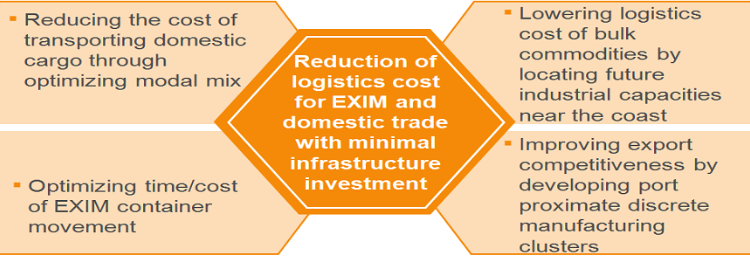Sagarmala Projects | 07 May 2022
For Prelims: Sagarmala, Sagartat Samriddhi Yojana.
For Mains: Infrastructure, Growth & Development, Government Policies & Interventions.
Why in News?
Recently, the Union Minister for Ports, Shipping and Waterways (MoPSW) chaired the meeting of the National Sagarmala Apex Committee (NSAC) at Vigyan Bhawan, in New Delhi.
- NSAC is the apex body providing policy directions and guidance for port led development-Sagarmala projects and reviews its implementation. It was constituted in May, 2015 by the Union Cabinet.
- Holistic development of coastal communities through a new initiative ‘Sagartat Samriddhi Yojana’ was discussed in the meeting.
Sagartat Samriddhi Yojana
- Prime Minister launched the Sagarmala – Sagartat Samridhi Yojana during the release of “Maritime India Vision 2030” in March 2021.
- MoPSW formulated this detailed project to address challenges in coastal areas of the nation.
- The Sagartat Samriddhi Yojna has identified a total of 1,049 projects with an estimated cost of Rs. 3,62,229 crores.
- The four key areas in which this initiative falls include:
- Coastal Infrastructure Development
- Coastal Tourism
- Coastal Industrial Development
- Coastal Community Development
What is Sagarmala Project?
- About:
- The Sagarmala Programme was approved by the Union Cabinet in 2015 which aims at holistic port infrastructure development along the 7,516-km long coastline through modernisation, mechanisation and computerisation.
- The vision of the Sagarmala Programme is to reduce logistics costs for EXIM (Export-Import) and domestic trade with minimal infrastructure investment.
- Sagarmala could boost India’s merchandise exports to USD 110 billion by 2025 and create an estimated 10 million new jobs (four million in direct employment).
- The Ministry has started the ambitious Project of Sagarmala Seaplane Services (SSPS) with potential airline operators.
- Components of the Sagarmala Programme:
- Port Modernization & New Port Development: De-bottlenecking and capacity expansion of existing ports and development of new Greenfield ports.
- Port Connectivity Enhancement: Enhancing the connectivity of the ports to the hinterland, optimizing cost and time of cargo movement through multi-modal logistics solutions including domestic waterways (inland water transport and coastal shipping).
- Port-linked Industrialization: Developing port-proximate industrial clusters and Coastal Economic Zones to reduce logistics cost and time of EXIM and domestic cargo.
- Coastal Community Development: Promoting sustainable development of coastal communities through skill development & livelihood generation activities, fisheries development, coastal tourism etc.
- Coastal Shipping & Inland Waterways Transport: Impetus to move cargo through the sustainable and environment-friendly coastal and inland waterways mode.

